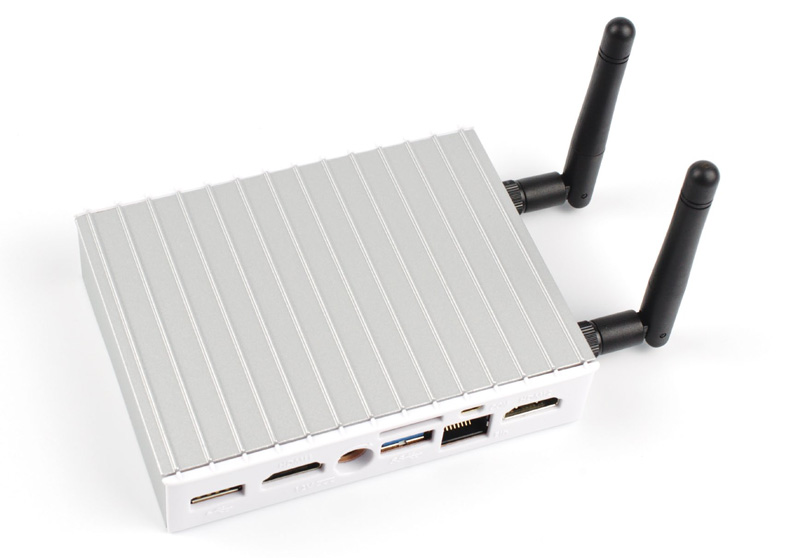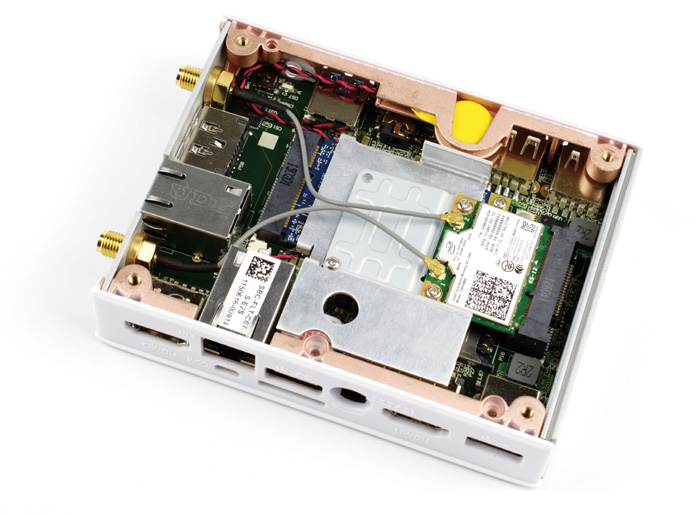Fitlet iA10 reviewed by Gareth Halfacree
Jan 05, 2016Gareth Halfacree reviewed and analysed the Fitlet iA10 in his regular Hobby Tech Column for Custom PC. Did you miss it? Don’t panic – here you go:
"Do you remember when you first saw the Intel Next Unit of Computing, and thought, ‘Blimey, that’s small?’ When the Fitlet arrived, I had a similar reaction made more impressive by the fact that the box I thought would be dominated by the machine itself was in fact mostly full of cables, accessories and a wall-wart PSU. If you need a small yet powerful computer, the Fitlet measures 108 x 83 x 24mm (W x D x H), with a volume of 0.215 litres. The smallest NUC model, by contrast, measures 115 x 111 x 32.7mm with a 0.417-litre volume.

Before you get too excited, though, there’s a disparity in performance to consider. The Intel NUC5i5RYK packs an Intel Core i5-5250U 1.6GHz dual-core processor; the Fitlet tops out with an AMD A10-Micro6700T 1.2GHz quad-core Mullins processor. On the plus side, the AMD chip has just a 4.5W TDP next to the Core i5-5250U’s 15W. However, the AMD chip is much slower, achieving only half the real-world performance of the Intel chip in CPU Mark.
Still, half the performance at less than a third of the TDP is nothing to be sniffed at, and the AMD chip – originally designed for compact, low-cost laptops – is more than powerful enough for desktop use and even light gaming, thanks to an accelerated processing unit (APU) design that includes Radeon R6 graphics with 128 stream processors running at 500MHz.
The Fitlet model reviewed here represents the top offering. It has 4GB of DDR3L memory and a 64GB mSATA SSD factory-fitted, and you can upgrade them to 8GB and whatever capacity you like respectively. Barebones models are also available, with the cheapest dropping to an AMD E1 Micro-6200T 1GHz dual-core processor for buyers on a budget.
You’re not buying a Fitlet for raw performance though – you’re buying it for a combination of flexibility and size. It’s in this respect that the spec sheet really starts to impress: the top-end model, as reviewed, includes three external USB 2 and two USB 3 ports, eSATA 6Gbps, two HDMI 1.4a outputs and a micro-SD slot.
There are also two Gigabit Ethernet ports hanging off an Intel I211 controller, dual-band 7260HMW 802.11ac Wi-Fi with twin external antennae and built-in Bluetooth 4.0, a mini-serial RS232 port and even a mini PCI-E slot for internal expansion, plus analogue and S/PDIF digital inputs and outputs.

In short, while its raw performance may be lacking there’s no shortage of flexibility – and we’re talking about a machine that’s not much larger than a cased Raspberry Pi here. There’s even a 14-pin 3.3V-logic GPIO connector, which requires an optional breakout cable but is otherwise accessible without opening the chassis. Sadly, at the time of writing I wasn’t able to test this feature.
Nevertheless, there was plenty to keep me interested in the Fitlet. The case, in particular, has a clever design, with metal top and bottom panels acting as a heatsink for the passively cooled, entirely silent system. CompuLab even includes an optional replacement lid featuring far larger fins for more demanding thermal environments, or for people who want to play around with the overclocking function built into the BIOS, which enables you to set a target TDP of up to 25W for the APU. Testing showed that it isn’t a gimmick either: setting a 10W target TDP saw an appreciable improvement in real-world performance, with diminishing returns past that point.
CompuLab is also serious about supporting the Fitlet community with plenty of accessories. As well as the GPIO cable and heatsink, the company offers VESA mounts and DIN rail mounts for rack applications. Plus, there’s even a pre-wired remote power switch for out-of-the-way applications.
The review sample was pre-loaded with Linux Mint 17.2, under which the Fitlet performed admirably. The network interface, in particular, impressed me, compared with the usual ARM-based boards I test, with a real-world throughput of 891.9Mb/sec.

However, folks used to seeing reviews of low-cost single-board computers in this column may want to sit down for this next bit, because it’s time to discuss price. In barebone configuration, the Fitlet iA10 unit on review here, minus RAM and SSD, will set you back £300 - putting the Fitlet iA10 in the same price league as Intel’s more powerful NUC5i5RYK, albeit in a smaller form factor and with added extras such as the second Gigabit Ethernet port, eSATA and GPIO when software support arrives. If those features and/or the smaller size aren’t your top priorities, though, the NUC5i5RYK is the more powerful machine.”
Discover the new range of Fitlet PC: Fitlet RM or read Gareth's review on Custom PC.
Related To This Topic:
Introducing Fitlet RM: The Next Generation of Fanless Mini PCs
Fitlet RM x Video: The Rugged AMD Micro PC For Networking
Fitlet PC powering Innovative Fire-Safety Networking Solution
 Part of
Part of